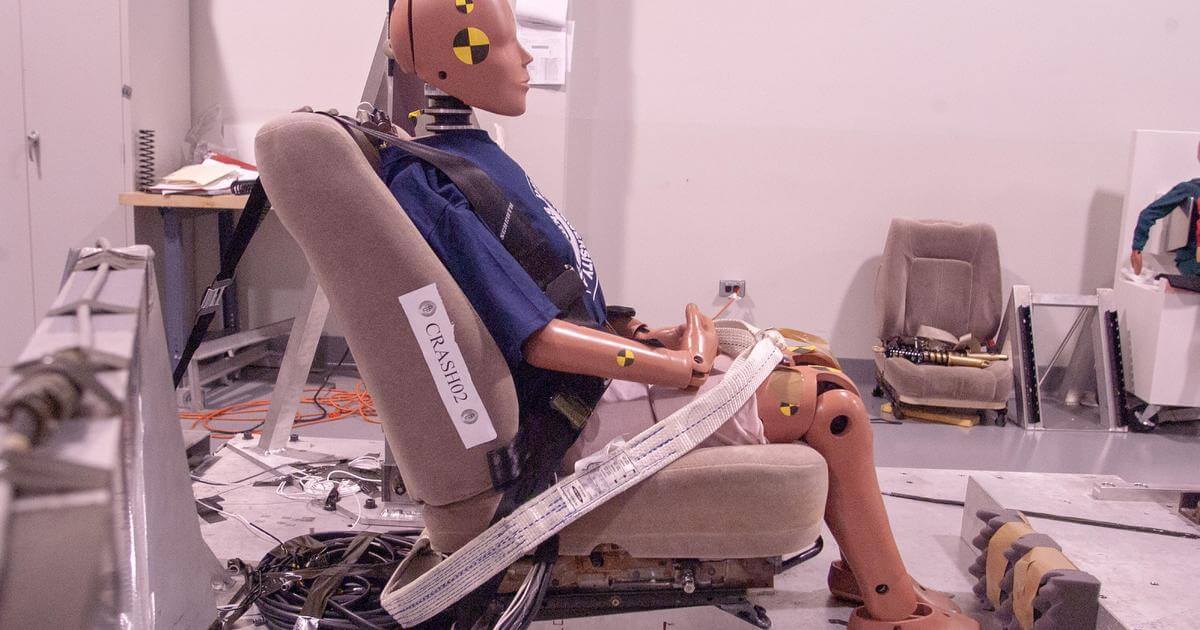
When President Biden signed the massive bipartisan infrastructure bill into law two years ago this week, it started a clock for the National Highway Traffic Safety Administration, known as NHTSA, to draft a number of new safety regulations, including one prompted by a multi-year CBS News investigation.
That two-year clock expired Wednesday without a new proposed regulation to improve the 56-year-old federal safety standard for vehicle seats. A CBS News investigation that began in 2015 exposed that the 1967 strength standard leaves vehicle front seats susceptible to collapse in rear-end crashes, putting children in the back seat at increased risk of injury or death.
This week marks 13 years since 16-month-old Taylor Warner, was killed when the family minivan was rear-ended while at a stop sign. The force of the crash caused her father Andy’s seat to collapse backward, colliding with Taylor, who was strapped in her car seat.
“It’s disappointing that after years of hard work with CBS and so many lives lost or negatively affected NHTSA didn’t make this a priority and allowed the deadline to pass,” Taylor’s mother Liz Warner told CBS News. “Our goal from the beginning has been to make sure this doesn’t happen to other families and their innocent children and by dragging their feet more and more people suffer.”
Two years ago when the infrastructure bill became law, Andy Warner told CBS News, “I don’t want her to die in vain.”
Safety advocates including the Center for Auto Safety in Washington, D.C., also expressed frustration with the missed deadline.
“The Center is disappointed that NHTSA has been unable to meet the Congressionally mandated deadline and begin the process of improving federal safety standards to prevent deaths and injuries due to seat back collapse,” said Center for Auto Safety executive director Michael Brooks. “We encourage the agency to prioritize this rulemaking, particularly since there have been decades of neglect in safety requirements for rear seats.” The Center also renewed its call on automakers to improve their seat designs in ways that aim to protect all the passengers in a vehicle.
Last week 10 Democratic senators wrote to NHTSA seeking an update on the status of the 10 auto-safety improvements called for in the bill, including the seat-back legislation. While praising NHTSA for its work in trying to reduce traffic-related deaths, they said, “now is not the time to turn on cruise control when it comes to road safety,” according to their letter. “After the passage of the [infrastructure bill], regulators have the green light from Congress to implement necessary, life-saving traffic safety provisions.”
Fatal motor vehicle crashes hit a 16-year high in 2021 but have ticked down slightly since then, to almost 43,000 last year.
“When Congress passed the Bipartisan Infrastructure Law, we told NHTSA that it is time to act on seat back safety,” said Democratic Senator Ed Markey of Massachusetts. “Now, the statutory deadline has passed, and lives are still at risk…I will be keeping the pressure on until families and parents know the front seats of their cars will not suddenly turn into deadly threats to their children seated behind them.”
Senators Markey and Richard Blumenthal, Democrat of Connecticut, led the effort in the Senate to change the seat strength standard. They are joined by Ben Ray Luján, Jack Reed, Chris Van Hollen, Elizabeth Warren, Amy Klobuchar, Dick Durbin, Ron Wyden and Sherrod Brown in the letter to NHTSA Acting Administrator Ann Carlson.
“NHTSA must stop stalling its implementation of the infrastructure law’s traffic safety wins as traffic deaths and injuries remain troublingly high. The public deserves swift action requiring rear seat alerts to prevent child hot car deaths, keyless ignition shutoff technology, strengthening seatback safety, and other key measures passed in this historic bill,” Sen. Blumenthal told CBS News.
In a statement to CBS News, NHTSA pointed to work it has completed, including a proposed rule to require automatic emergency braking in new vehicles and completed a directive from the infrastructure bill when it issued a new regulation allowing for adaptive driving-beam headlights in new vehicles.
“The agency is currently working to complete all Bipartisan Infrastructure Law requirements,” a NHTSA spokesperson said in a statement to CBS News adding, NHTSA “has already made significant progress on several of those directives.”
In December 2022, NHTSA indicated it would complete its required rulemaking on the new seat strength standard in “an unspecified amount of time that allows due consideration of public input,” according the senators’ letter.
It appears little has changed since the same senators inquired last year. NHTSA’s online dashboard shows the seatback regulation as being in the “Prerule Stage.”
“The only thing more important than moving quickly is getting it right,” Transportation Secretary Pete Buttigieg told CBS News in an interview in late August. “We’ve got an amazing team at NHTSA that is working crazy hours under enormous pressure to issue a number of rules that are required by Congress. We’re going to get through that process. We’re going to do it as quickly as we responsibly can, but the No. 1 priority is to get it right.”
Calling auto safety reforms the No. 1 place where the Department of Transportation can reduce injuries and deaths, Buttigieg said the goal was to complete the work no later than January 2025.
“We want to get every piece of this that we can done before the end of this term.”
In the course of the multi-year investigation, CBS News found crash test after crash test showing what can happen when a seat collapses: the driver is launched into the back seat, where children are often seated.
Yet reporting found that all the seats that failed in these types of rear-end collisions met or exceeded the half-century-old federal strength standard.
In the early 1990’s, NHTSA’s own researchers warned the agency about seatback collapses, citing examples of major or fatal injuries.
And carmakers have long known it is an issue. During a 1996 deposition, a General Motors engineer said the automaker started tying down its test dummies because they were “expensive” and the chances of losing them “were pretty high.” Another deposition with a GM engineer revealed that the cost to fix the problem was “on the order of a dollar or so” per seat.
Kris Van Cleave is CBS News’ senior transportation and national correspondent based in Phoenix.
Original Article: https://worldnewsera.com/news/politics/nations-top-auto-safety-regulator-misses-deadline-on-potentially-life-saving-new-rules-for-vehicle-seats/


